Fermi Goes Mobile: AVADirect's Clevo W880CU with GTX 480M
by Dustin Sklavos on July 7, 2010 11:45 PM ESTApplication Performance and Battery Life
Just to be completely safe, we did run an additional three tests to see how the NVIDIA GeForce GTX 480M might affect system performance outside of gaming. The usual suspects were run: Futuremark's Peacekeeper, Cinebench R10, and our x264 video encoding test.
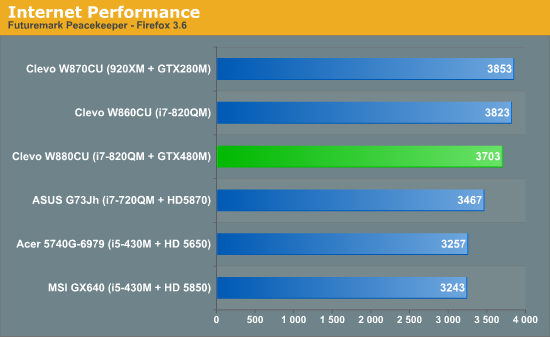
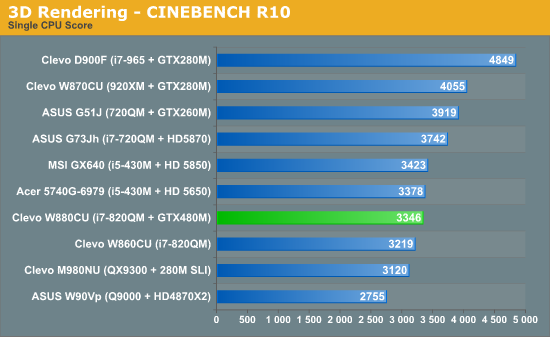
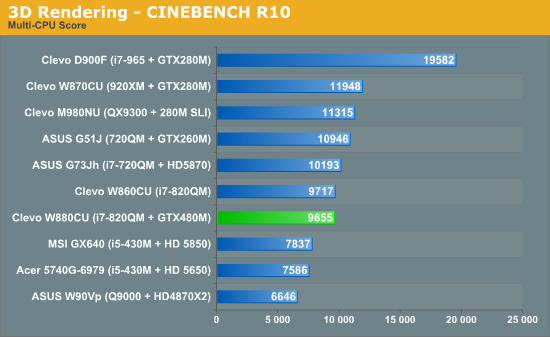
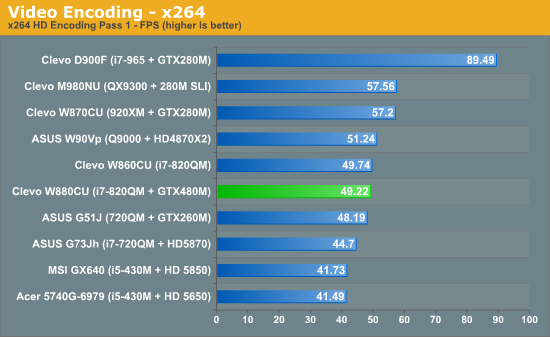
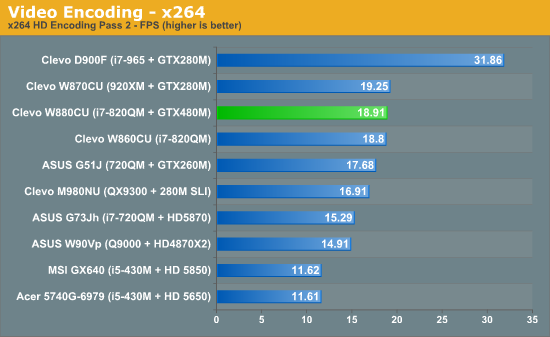
In each situation, the W880CU with its Intel Core i7-820QM falls in line with the previously tested W860CU systems.
We recently had a discussion in our forums that ultimately degenerated a bit into the old NVIDIA vs. ATI war: is NVIDIA hardware a superior option if you'll be using Adobe software? Adobe and NVIDIA both proudly tout increased GPU reliance in Creative Suite 5, culminating in what Adobe calls its "Mercury Playback Engine" in Premiere Pro CS5, a playback system supposedly accelerated by CUDA.
I personally use Premiere Pro and After Effects CS5 for video work on my own desktop, equipped with an ATI Radeon HD 5870, and in none of the CS5 applications have I ever felt like I was missing any secret sauce. It's important to note that features aren't going to be disabled if you aren't running NVIDIA kit, but we figured we'd give the GTX 480M a chance to prove itself in Premiere Pro CS5.
That didn't happen. Presently the 480M isn't supported in CS5; in fact the only NVIDIA hardware supported by the Mercury Playback Engine are the GeForce GTX 285 and several of NVIDIA's expensive workstation-class cards. NVIDIA informs us that other GPUs like the 480M are not supported at launch but Adobe is planning on increasing the number of supported GPUs in the near future. How long that will take is difficult to say (Flash 10.1 took over six months to go from Beta to final release), but at some point in the future Adobe should patch in support for additional NVIDIA hardware. For now, that means we can't make a convincing case for the GTX 480M against the competition if you're going to be using Adobe CS5 software.
If you were looking for a healthy benefit to the 480M, though, you can check out how well it sips power at idle.
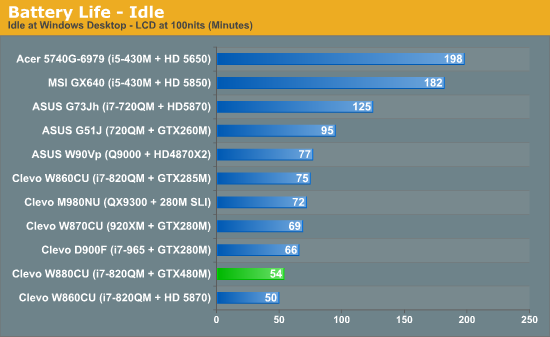
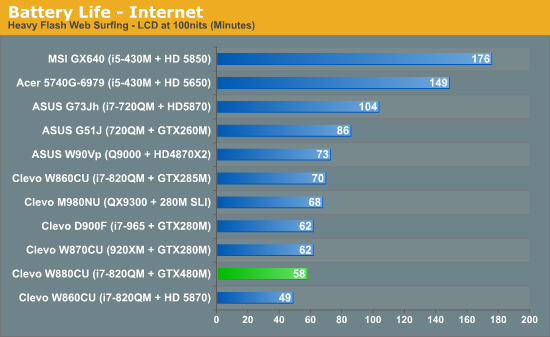
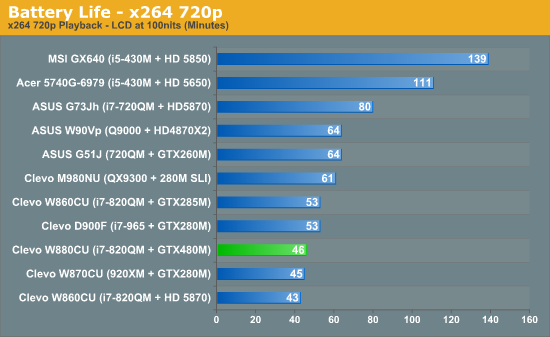

It's true the 3-cell battery in most of these Clevo notebooks is essentially a UPS system, but the ability of NVIDIA's chips to power down so much at idle (ignoring the clear benefits of Optimus in other notebooks) is nonetheless appreciated. The more power a chip draws, the more heat it's liable to produce, and thus the harder the cooling system of the notebook is going to have to work. While you would almost never take this monster off its leash, at least the GTX 480M is pulling its weight by not chugging power from the anemic battery. It essentially matches the ASUS G73Jh in power requirements when unplugged, albeit with a battery that's half the capacity.
Do note that as with other Clevo notebooks, the W880CU will kick the GPU into "limp mode" on battery power, regardless of settings, so you're not going to be playing 3D games at high detail on battery power (for 20 minutes) even if you want to.










46 Comments
View All Comments
7Enigma - Thursday, July 8, 2010 - link
That's really cool. Thanks for the post. My cousin does Adobe work and I belive has the GTS 250 with either 512 or 1gig memory. I'll have to try this out the next time I'm over his place.therealnickdanger - Thursday, July 8, 2010 - link
The best part is that Adobe is aware of this tweak and has no plans to "turn it off". While using this method is not officially supported, it appears to be unofficially encouraged.:)
B3an - Thursday, July 8, 2010 - link
Surely NV will be supporting CS5 with atleast the 4xx series? Why only have the 285GTX support it for non-workstation cards?therealnickdanger - Friday, July 9, 2010 - link
NVIDIA doesn't have much say in the matter. It's Adobe's software, Adobe's engine.The 4xx series works exceptionally well with the tweak, so it's a non-issue anyway.
Gunbuster - Thursday, July 8, 2010 - link
Can we get a benchmark with a CrossfireX HD 5870 Laptop?frozentundra123456 - Thursday, July 8, 2010 - link
I like the idea of a 1000-1500 dollar gaming notebook for moderate gaming, but I dont think this notebook is anywhere near worth the price. For 3000 dollars, one could buy a mid level notebook for moderate gaming and buy/build a 1500 dollar desktop that would have excellent performance.angelkiller - Thursday, July 8, 2010 - link
I'm still not satisfied with their naming scheme. I do think this is a step in the right direction though. This time at least the name refers to the correct architecture. But the GTX 480M isn't a mobile version of a GTX 480. It's more like a GTX 465M. And this isn't just a Nvidia problem. The Mobility 5870 isn't a mobile version of a 5870.I think the idea of naming laptop cards after desktop cards is flawed to begin with. Instead, laptop cards should have their own series name. Then the name would never be misleading. Then the ATI Mobility <Series Name> could be based off the desktop Juniper chip and nobody would care. The name wouldn't refer to something that the card isn't. Hopefully that made sense.
I also wanted to say that I've really been digging the articles AT has been putting out lately. Very thorough and informative analysis. Keep it up!
anactoraaron - Thursday, July 8, 2010 - link
I completely agree. The 480M isn't "properly named". It should be named 465M.Also, I could care less who (nVidia or ATI) has the 'fastest' card as long as it's practical... MSI has a new laptop (reviewed here on AT) that still gets 2~3 hrs of battery life with a mobility 5870. In my mind, the superior product is the one that can actually be used not plugged in all of the time. And I don't need to re-hash all of the impractical reasons to get the desktop fermi... I still can't get the "epic fail" taste out of my mouth from this series of graphics cards from nVidia.
Dustin Sklavos - Friday, July 9, 2010 - link
The thing is, at least the 480M is the same freaking silicon as the desktop 480. It may be crippled, but it's the same chip. The same can't be said about...well...pretty much anything else in Nvidia's mobile lineup. ATI was doing well in the 4 series, but their 5 series is nearly as bad. 5700s = desktop 5600s, 5800s = desktop 5700s.therealnickdanger - Friday, July 9, 2010 - link
That doesn't make sense. The desktop 470 and 465 are also "crippled" versions of the 480, but at least they are appropriately named. That's the point."NVIDIA's GTX 480M uses the same cut-down core found in desktop GeForce GTX 465 cards."
480M:
352 CUDA Cores
256-bit
GDDR5
GTX465 Desktop:
352 CUDA Cores
256-bit
GDDR5
GTX480 Desktop:
480 CUDA Cores
384-bit
GDDR5
So logically, if the 480M is the SAME as the desktop 465... then it should be called the 465M, not the 480M. Technically speaking, NVIDIA does NOT make a mobile GTX 480. It's misleading and just plain nonsense.
ATI is no better.